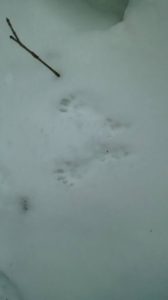After the recent ice storm, a couple of mild weather days afforded us the first opportunity to do habitat work in reasonable comfort. With the help of volunteer Ray and intern Mikayla, we took to the forest to continue where we left off along Columbus St. last fall- where the honeysuckle and buckthorn thrive. Or try to thrive. Even though our task was to cut, pile, and treat the stumps of these invasives, not glamorous work by any means, it felt so good to get out in the preserve again to try to improve the land.
The work reminds me of days long ago when mild winter days included making firewood. The slushy wet snow meant wet feet unless one’s boots were properly oiled, and wet hands, regardless, because work gloves always were soaked. The air has a damp, earthy smell of wet leaves and bark, but at least there is an odor, unlike the dry sterile air of the really cold days. Working along, cutting away at the stems, there is so much to see: last fall’s deer rubs and last night’s tracks, drip marks beneath the trees, green woodfern and tan bracket fungi, woodpecker holes, a red squirrel’s imprints, wild cucumber husks- all familiar forest features and yet seeming different in the winter season.

Squirrel tracks
Chickadees follow unafraid to see what we are doing, examining the leftover berries of European cranberry and buckthorn-leftover because they are neither as nutritious or palatable as native fruit. It is somehow so rewarding to find in a tangle of honeysuckle the stem of a native tree or shrub, a black cherry or speckled alder, or even a lowly red-twig dogwood, that can be liberated from the onslaught of the invasive. Carefully we trim the invaders from around the native plant in the hopes that we are turning the tables, allowing the native to someday reclaim the territory.
Earlier in the fall we had seeded the area with a variety of shade-tolerant wildflowers meant to enhance the habitat for pollinating insects. We also hope to reduce the heavy shade of the honeysuckle/buckthorn canopy so that the bumblebees can thrive here. One such bumblebee, the rusty-patch, has just been designated as endangered. The species has been documented near here and we hope that we can provide a place for them, too, among our native plants and birds.
We have a sign on Conifer Trail that states that invasive plants are the bullies of the forest. I enjoy that comparison- the invaders do seem to indiscriminately overwhelm all of the native plants save those which are already taller than the invasives. Bullies are no better in a forest than they are in the human world, and they shouldn’t be tolerated in either. So on we go, slogging in the slush, cutting and treating. When the time is right, we’ll re-plant to promote a more diverse and stronger forest community, all the while thinking about how lucky we are to live here on the Lakeshore in such a wonderful area. Sometimes the task seems overwhelming, but after a while one can see bits of progress that add up in the long run. Although it is hard work, we realize what we’re doing is good for nature. Our work also enhances places to visit, and that activity on the whole is good for us as well.
Happy 2017. Onward and upward. And pass the ibuprofen.
Photo- red squirrel tracks in the forest
